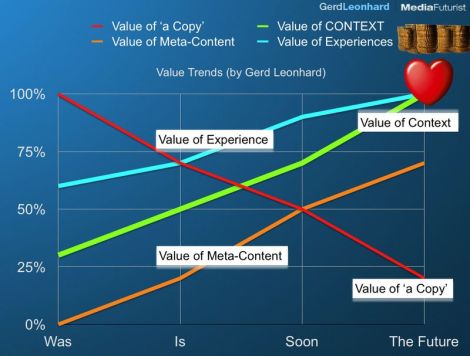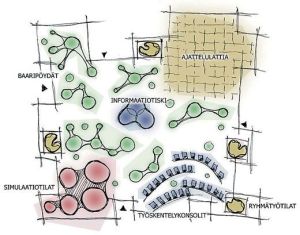3 July, 2009
Mårten Mickos on effective teams
I am reposting a great summary of team building, expecially for executives. By Mårten Mickos of MySQL.
1. The team members ask each other “How can I support you?”
2. The team members hold each other accountable while also allowing each one to show vulnerability.
3. The team practices open and authentic communication.
4. The team arrives at key decisions together through discussion, debate, and synthesis.
5. The team has fun.
6. The team members see success of the whole team as the best form of success.
7. The team operates at a strategic level and empowers the organization around them to make and execute operational decisions.
8. Each team member builds his/her own teams following these principles.
And there is an implicit characteristic number zero (which should be self-evident): 0. Each team member individually follows Drucker’s eight practices for effective executives.
Some observations and further comments on the team practices:
Item 1: In a great executive team, all executives help each other, and they engage in the broad management of the business and not just in their own area of responsibility. This cannot happen if there is a team member with a supersized ego. So by defining this practice, we are also saying no thanks to people with egos too big to fit inside an effective team.
Item 2: There is a virtuous circle in all of this (and a vicious one in the opposite scenario): When each team member does his/her job, trust emerges between team members. When there is trust, you can admit and show your vulnerabilities and weaknesses. When you can admit your weaknesses, you are also bound to improve. When you improve, you do your job better. When you do your job better, more trust ensues.
Item 3: It could be added that this practice is both about communication inside the team and outside.
Item 4: How a team arrives at decisions is a very important issue. Note that it says “key decisions” — non-key decisions can be made individually or at a lower level in the organization. Arriving at a decision “together” means that everyone will be heard, dissent will be encouraged, pros will be weighed against cons, and so on. But it does not mean that it is a democratic decision or a decision by consensus. At the end of any decision-making process in a corporation, there will be a single responsible decision-maker (many times, but not always, the CEO) who will have to make the final call. But during the process, he/she will engage the whole team and build up better insights, common understanding, and broad commitment, no matter what the ultimate decision will be. Many times in such an open decision-making process, new ideas emerge that shape the ultimate decision.
Item 5: Fun means genuine fun, not superficial fun. Fun doesn’t require money, great surroundings, great food, or great wine. We have nothing against those things, but at the end of the day they are not vital for having fun. They only add luster to something that it is fun by itself. Fun happens when human beings interact on a plane deeper than what they are used to or what they expected.
Item 6: It takes a lot to get a team in a condition where overall success is more rewarding than success of any given individual. But when it happens, it is an amazing feeling for all involved (and for all who are observing from around), and it produces better results.
Item 7: Teams need to not micromanage the world around them, but to build layers of managers and teams that can run the show.
Item 8: Building a team is very difficult, but also incredibly rewarding.
My hope is that these practices can be useful to those who build executive teams. I have seen, participated in and built a number of executive teams in my career and I know firsthand the turbo boost a company gets from having an effective executive team. The one we built at MySQL was unique in this regard, if I may say so myself. I am very eager to hear comments and suggestions for improvements on this text. Please send them to
7 April, 2009
8 key trends and some foresights for the next 5 years
 I’m becoming a bit of a fan of Gerd Leonhard. Gerd’s work focuses on the Future of Media, Content, Technology, Business, Communications and Culture, and he is considered a leading expert on topics such as Web/Media 2.0, social networking and social media, cultural changes due to disruption by new technologies, copyright vs. technology issues, online content commerce models, media convergence, mobile entertainment, entrepreneurship, the future of advertising and branding, future planning, digital content strategies and next-generation business models.
I’m becoming a bit of a fan of Gerd Leonhard. Gerd’s work focuses on the Future of Media, Content, Technology, Business, Communications and Culture, and he is considered a leading expert on topics such as Web/Media 2.0, social networking and social media, cultural changes due to disruption by new technologies, copyright vs. technology issues, online content commerce models, media convergence, mobile entertainment, entrepreneurship, the future of advertising and branding, future planning, digital content strategies and next-generation business models.
In his latest post on MediaFuturist he gives an amazing rundown of future development within media. Here are the key points, please read the complete post.
1. We will soon see the emergence of many different kinds of iPhone-influenced Netbook-like devices
2. Very cheap or free wireless broadband – at fairly high speeds, i.e. at least 2MB / sec
3. Collective blanket licenses that legalize and unlock legitimate access to basic content services via any digital network
4. Fuel-cells and other next-generation mobile energy sources are a certainty
5. Completely targeted and personalized advertising
6. the core economic business models – of newspapers, magazines, CDs, DVDs and books will be completely re-written
7. Today we pay to go online and connect; in the future we may end up paying for the luxury to go offline
8. Travel 2.0: alternatives to ‘actually going there’
29 March, 2009
The Future Of Music And Media
Vodpod videos no longer available.
21 February, 2009
Home in 2040
There was an interesting article in Tekniikka & Talous webzine in Finland about a design vision of a home in 2040. Below is the English translation.

”I wake up in my multiroom box and go from the bedroom to the bathroom. When I return through the same door, bedroom has turned itself into a kitchen, as my home will guess that it will the step in my morning routines.
The breakfast is already made. I spread the table wider with my hands and look around. I’m in a Parisian cafe. With a gesture of my arm the view changes in a safari scene. I pick up a banana, peel it up and throw the rubbish on the table, which instantly drops it into the waste disposal system.
I go to work at a wikibar, which is at the street level of my condominium. At the wikibar, I go to the brainfloor, which stimulates my senses and wakes me up for thinking. At the workconsole I will save the intuitive created thoughts and continue to the team working space. My colleagues are gathering there as well.
Our ideas are displaced on the walls, the space will listen to us and saves all the new thoughts from the brainstorming.
We have a break at the bar, where I get a new idea. I go the information display, which does offer me more info about the subject. After the break, our team goes to simulationroom to have a look at the plan, product or project would look like when completed.
After work I go to the condominiums meeting space. I will meet my family and friends, pick up an apple and sit by the river under a blue sky. In reality the meeting space is part of the series of rooms, but with display systems and mirrors, it looks very realistic outdoor space. In our room its spring, though elsewhere it could winter wonderland or a tropical sunset.”
This is a vision of architecture engineering student Juuso Kangas about living in 2040. He is a member of the group which won a Finnish award for future visions.
The core idea around the vision is “metamaterial”, in which the material will mold into the needs of the user guided by AI. Bedroom will become living room and the bed becomes a couch. The design sculpture becomes a table.
Metamaterial creates a wealth of opportunities. In the future, shops are not selling pieces of furniture anymore, but codes for materials that creates certain shapes.
17 September, 2008
Basshunter Diary pt. 4
After five days on the road and about 10 photoshoots and TV interviews later someting opened my eyes. All these directors who are working on the projects…hmmm…for maybe because they have to pay their rents, but not because their heart is at it. They tell the artist to be normal, but do not really understand what is needed. Me instead am working slowly to gain the trust of Basshunter and thus getting more realistic side of him on the road. This all leads back to why Anton Corbjin is so good: he is one with the artists, not above or below.
In addition, Basshunter project has confirmed something. Pop culture embraces all the layers of the package. Brian Eno says it well:
You sometimes hear something being dismissed because it’s all image and no substance, as though these are completely separate, the first ephemeral and lightweight, the second profound and permanent. But one of the messages of pop culture is that you can’t usually separate them: ‘image’ is constantly turning into ‘substance’, and vice versa. The package is part of the contents.
This represents a decision about where the edge of the work really is. What is being seen as the permissable site for creative work by the artist, and what is just ‘the rest of the world’? What is ‘inside’ and what is ‘outside’?
This problem – if you think it one – is particularly acute in pop music. When Madonna appeared, she was attacked for her concentration on everything other than the music – on the things that people call the package. Even if this had been true, would it have been so awful? Who said that pop music was ever just to do with melodies and lyrics and whatever else the word ‘music’ historically meant? For forty years, pop music and its culture have been at the center of the everyday conversation that our culture has with itself, and the talk is mostly about style: how you choose to look at things, how you value what you are and what you have and what you do. Lifestyle, I suppose is the word.
Is short: for Madonna, designing the package has become her work.
Most directors’ and photographers’ problem is that they try to loose themselves in situations where it is impossible. How about trying to loose yourself in a real situation where the artist really can feel normal and does not have to pretend the camera is not there. Just let camera be there!
In a wider aspect this gets down to the fact that one has to know the subject being directed. Whether a film director, music producer, academic or company director.
Behind The Bass on Hard2Beat. Tour documentary about Basshunter.
15 July, 2008
Why Music Market Is Going Down?
 Continuing the yesterday’s post about EMI cutting costs and becoming profitable again. As noted I am glad that EMI is being restructured, but I would not hail for the current success of the label becoming profitable again. Unless there is deeper reasons for this fortune turnaround….by the way, this is the reason I turned away from music into films.
Continuing the yesterday’s post about EMI cutting costs and becoming profitable again. As noted I am glad that EMI is being restructured, but I would not hail for the current success of the label becoming profitable again. Unless there is deeper reasons for this fortune turnaround….by the way, this is the reason I turned away from music into films.
Following text from my academic study in 2006:
Significance Of Album Cover Art As A Branding Tool
Musicologist and philosopher Theodor Adorno (1941), who is possibly the most significant theorist in discussions about popular music, argued that popular music is nothing but entertainment and far from music’s true aesthetics. However Longhurst (1995) analysed Adorno’s extremely critical approach to popular music as being not a criticism of musical content, but a concern between music that is market orientated and music that is not. In other words, Adorno raises the question if marketing and branding requirements limit the quality of music from musicological point of view. In relation to this, Brown & Patterson (2000) argue that marketing can be harmful for the artist. ‘Pop-culture and pop-art could be related to the ‘silent-disdain’ heritage sites, as being entertaining rather than educating; displace decontextualised art; being all the same despite minor surface variations.’ They especially point out that all art is in the hands of multi-national capital and mendacious marketers with logos, branding and promo stunts. In short, business orientation is trivialising and twisting the truth. ‘Worst of all they pursue lucre and profit maximation’. However, the Director of Barbican Art Centre in London, John Tusa (1999) says that even though art and marketing are distinct concepts, both have a similar goal of having an audience, which generates income to survive. So they have to live together in contemporary society.
In short, to turn around a music label one should not become market orientated, but combine the understanding of business orientated product/package and art orientated substance. Not just pursue the profit maximation. That is the way for a sustainable future.
Other arts pursue profits as well but still have opportunities for analytical and emotional study of the world. Therefore, and I repeat, I would like to see a report on the creative output as well.
29 February, 2008
Album Cover Art as A Branding Tool
 This is a little blast from the past. I think I have never uploaded my academic research work to this blog, so lets correct that mistake right now. And to be honest, currently is it downloaded about 200 times per month from another site, which means that there is interest towards it.
This is a little blast from the past. I think I have never uploaded my academic research work to this blog, so lets correct that mistake right now. And to be honest, currently is it downloaded about 200 times per month from another site, which means that there is interest towards it.
In a nutshell, this work covers areas of album cover and its significance on the branding of music using the band HIM as a case study. I believe music is a product that is mainly sold through visual representation. Although the core product is the music, there is increasing need of cover art, logos, photos, live visuals etc. All this constitutes to the branding of the music.
Download Significance of the Album Cover Art as A Branding Tool!
The main finding of this research indicate a need for thoughtful use of visual aspect in music and also showcase certain characteristics of branding that are useful while producing album covers. In a Post-Modern society people buy the message, rather than the music, communicated through different methods of music, promotion, marketing and branding. Well signified album cover, operating like an advertising, reflects a focused message that is easy for consumers to understand.

